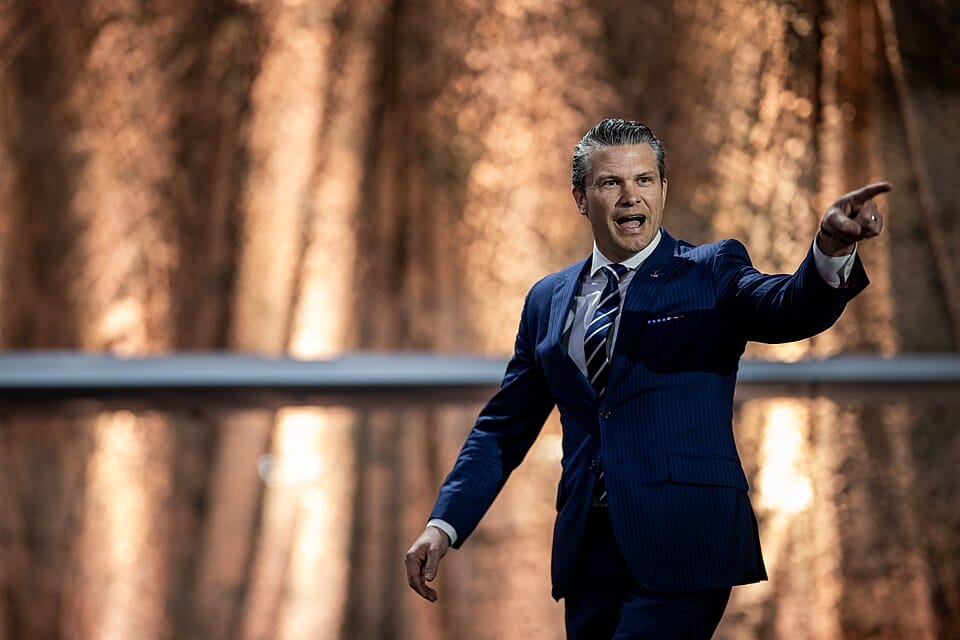Instead of Leadership, War Secretary Hegseth Delivers A Campaign Speech

It was a grand occasion, as every general officer and Admiral of the US Military was brought together in one room to discuss the new directives and priorities of the newly renamed US Department of War.
For days, speculation has raged as pundits and analysts have tried to determine the meeting's agenda. What was so vital that Secretary Pete Hegseth would bring all the military "brass" together in one location? In itself, this was a reckless and dangerous move, a temptation for any enemy to decapitate, in one fell swoop, the Nation's military leadership. Not to make too fine a point, but when President Trump joined the meeting, that extended the risk of decapitation.
Indeed, there was much to discuss; the risk of armed conflict has never been greater. America is actively engaged in supporting two wars, one in Ukraine, the other in Gaza – neither of which could proceed without US weapons and supplies. Additionally, it appears that we are headed toward new battles against Iran and Venezuela.
Before this military confab, most of the speculation centered on these existing conflicts. Surely Secretary Hegseth and President Trump must be preparing our fighting forces for some escalation on one of these fronts: Iran, Ukraine, Israel, or Venezuela – at least that was the thinking.
Even more concerning, this past year, the risk to our country has grown, as negotiations for peace have failed, and the capabilities of the enemy have grown. Our two Peer Opponents, Russia and China, have introduced new and innovative weapons in their respective arsenals.
For Russia, there was the dramatic introduction of the Oreshnik, a hypersonic mid-range missile never seen before – but used to devastating effect in destroying Ukrainian war factories last year. Not only did this new weapon seem capable of providing overwhelming destruction using mere kinetic projectiles, but it also appeared to defeat America's premier air defense, the Patriot Anti-Aircraft battery.
China, on the other hand, used a massive military parade to display not only its incredible coordination of marching troops but also introduced weapons the world had never seen. New unmanned drones and fighter aircraft that would present an incredible challenge to any opponent. Russia and Iran have both used large numbers of unmanned drones to overwhelm defenses in Ukraine and Israel. Military drone technology, as well as hypersonic missile technology, appear to be two areas where our opponents currently have an edge.
So, the speculation was that US generals and admirals would be introduced to new American Military Technology to counter our opponents.
Indeed, as Secretary Hegseth strode the stage, that looked like exactly where this meeting was heading. To quote the Secretary:
From this moment forward, the only mission of the newly restored Department of War is this: warfighting, preparing for war and preparing to win, unrelenting and uncompromising in that pursuit not because we want war, no one here wants war, but it's because we love peace. We love peace for our fellow citizens. They deserve peace, and they rightfully expect us to deliver.
https://www.war.gov/News/Transcripts/Transcript/Article/4318689/secretary-of-war-pete-hegseth-addresses-general-and-flag-officers-at-quantico-v/
It was a powerful beginning to what was supposed to be a newly reconstituted United States Military. An introduction to America's new fighting force. A way to overcome some of the deficiencies of the past. Presumably, Hegseth could have demonstrated how his Department would improve military logistics. After all, one of the glaring shortcomings of our existing conflicts has been our inability to provide weapons and ammunition to our allies in Ukraine, Israel, and across the globe. Logistics are one of the most pressing issues for the new War Department.
Or perhaps Hegseth would introduce new leading-edge technology that would bring us solidly into the 21st century. Would he reveal some new American hypersonic missiles nearing production? Or announce US drone production that will match China or Russia? Or will he show how we will now produce the Patriot Anti-Aircraft Systems that our Allies are requesting?
Regrettably, none of those speculations turned out to be the case. Instead of addressing the formidable challenges that this country faces on any new battlefield, Hegseth hid behind that overused shibboleth, "we're the greatest."
Hegseth then went on to rail against the political and social factors that he believes have weakened the Military. He railed against inappropriate "Rules of engagement," "MOS" (Military Occupation Specialty Code), DEI (diversity, equity, and inclusion) recruitment, and other social/political initiatives. Naming specific past generals as responsible for these missteps: the Chiarellis, the McKenzies, and the Milleys.
It was entirely inappropriate – fighting against past Commanders in this setting was uncalled for. It's doubtful that any of the current commanders assembled had anything to do with those decisions, most of which were made at the Presidential level. To now drag today's leadership through that past was out of line.
What the assembled military leadership was looking for were exact methods and innovations that the current Secretary of War would provide to support the Military's current challenges and missions. How would Hegseth, and by extension the President, supply the new weapons and armaments that our opponents have shown? Moreover, how would Hegseth and the President provide the necessary systems and logistics to deliver those weapons and armaments when the Military goes into battle?
This conference was not a meeting worthy of its expense or the risk it entailed. It was a campaign exercise in which Hegseth and President Trump chose to replay past political speeches.
Follow me here on ValueSide for more articles like this.